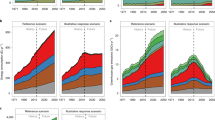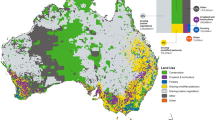Abstract
This paper outlines a process for exploring food system vulnerability and resilience using scenario modelling with the Australian Stocks and Flows Framework (ASFF). The capacity of ASFF to simulate how diverse shocks and stressors affect food system behaviour across multiple sectors—with diverse, interconnected and dynamic variables shaping system response—renders ASFF particularly suited for exploring complex issues of future food supply. We used ASFF to explore the significance of alternative agricultural policies for land use, crop production, livestock production, fisheries, food processing, transport, food waste and ultimately food supply. Policies in different scenarios varied with regard to the timetable for reducing greenhouse gas emissions, the degree of government participation or regulation in the food system and the scale of solutions (varying from centralized and global to decentralized and local). Results from the scenarios suggest that Australia does not have the ability to maintain a domestic surplus of foods required for a nutritious diet. In particular, the health of the current food system is highly vulnerable to constraints in oil supply, and increased food production threatens to precipitate a drastic decline in critical water supplies. We conclude by outlining a proposed method for using ASFF to delve deeper into the dynamics of the food system, probe the consequences of various adaptive responses to food production and supply challenges and devise potential indicators for food system resilience. Shocks and stressors to be added to the next phase of scenario modelling include soil salinity, climate extremes and credit scarcity. The ASFF methodology should be applicable to other parts of the world, although appropriate recalibration and adjustment of model assumptions would be required to reflect regional differences.






Similar content being viewed by others
References
Apeldoorn DFV, Kok K, Sonneveld MPW, Veldkamp T (2011) Panarchy rules: rethinking resilience of agroecosystems. Evidence from Dutch Dairy Farming. Ecol. Soc. 16
Australian Government (2014) Green paper on developing Northern Australia. Department of Premier and Cabinet, Canberra, Australia. Online: http://apo.org.au/sites/all/modules/pubdlcnt/pubdlcnt.php?nid=40013&file=http://northernaustralia.dpmc.gov.au/sites/default/files/papers/green_paper.pdf
Bartos S (2012) Resilience in the Australian food system. Australian Government, Department of Agriculture, Forests and Fisheries, Canberra, Australia. Online: http://www.tisn.gov.au/Documents/Resilience%20in%20the%20Australian%20food%20supply%20chain%20-%20PDF%20copy%20for%20web.pdf
Baynes TM, Turner GM, West J (2010) Historical calibration of a water account system. J. Water Resour. Plan. Manag. 137:41–50
Chai CL, Liu X, Zhang WJ, Baber Z (2011) Application of social network theory to prioritizing oil & gas industries protection in a networked critical infrastructure system. J. Loss Prev. Process Ind. 24:688–694. doi:10.1016/j.jlp.2011.05.011
Chang SE, McDaniels T, Fox J, Dhariwal R, Longstaff H (2014) Toward disaster-resilient cities: characterizing resilience of infrastructure systems with expert judgments. Risk Anal. 34:416–434
Commonwealth Department of Health and Ageing (1998) Australian Guide to Healthy Eating. Commonwealth of Australia: Canberra. Online: http://www.healthpromotion.com.au/Documents/CIM/fdcons.pdf
Dalal RC, Mayer RJ (1986) Long term trends in fertility of soils under continuous cultivation and cereal cropping in southern Queensland. I. Overall changes in soil properties and trends in winter cereal yields. Aust. J. Soil Res. 24:265–279
Dunlop M, Howden SM, Turner GM (2004) Future sustainability of the Australian grains industry. CSIRO Sustainable Ecosystems, Resource Futures Program
Erb KH, Haberl H, Krausmann F, Lauk C, Plutzar C, Steinberger JK, Muller C, Bondeau A, Waha K, Pollack G (2009) Eating the planet: feeding and fuelling the world sustainably, fairly and humanely—a scoping study. Commissioned by Compassion in World Farming and Friends of the Earth UK. (No. Working Paper No. 116). Institute of Social Ecology and PIK Potsdam, Vienna, Austria. Online: http://www.ciwf.org.uk/what_we_do/factory_farming/eating_the_planet.aspx
Ericksen PJ (2008) What is the vulnerability of a food system to global environmental change? Ecol. Soc. 13(2):14
Ericksen PJ, Ingram JS, Liverman DM (2009) Food security and global environmental change: emerging challenges. Environ. Sci. Policy 12:373–377
Ericksen PJ, Stewart B, Dixon J, Barling D, Loring P, Anderson MD, Ingram J (2010) The value of a food system approach. In: Ingram J, Ericksen P, Liverman D (eds) Food Security and Global Environmental Change. Earthscan, London, United Kingdom
Falasca M, Zobel CW, Cook D (2008) A decision support framework to assess supply chain resilience, in: Proceedings of the 5th International ISCRAM Conference. pp. 596–605
FAO (2006) Food Security. Policy Brief Issue 2 (June 2006). Food and Agriculture Organisation of the United Nations, Rome
FAO (2011) The state of the world’s land and water resources for food and agriculture: managing systems at risk. Food and Agricultural Organisation of the United Nations, Rome, Italy. Online: http://www.fao.org/docrep/017/i1688e/i1688e.pdf
Farmar-Bowers Q, Higgins V, Millar J (eds) (2013) Food security in Australia. Springer US, Boston, MA
Filippini R, Silva A (2012) Resilience analysis of networked systems-of-systems based on structural and dynamic interdependencies, in: PSAM 11 & ESREL
Forrester J (1971) Counter-intuitive behaviour of social systems. Technology Review 73(3):52–68
Garnaut R (2008) The Garnaut Climate Change Review. Cambridge University Press, Port Melbourne, Final Report
Gault FD, Hamilton KE, Hoffman RB, McInnis BC (1987) The design approach to socio-economic modelling. Futures 19:3–25
Giannopoulos G, Filippini R, Schimmer M (2012) Risk assessment methodologies for Critical Infrastructure Protection. Part I A state of the art (No. 0039033278957). Ispra
Giraldo DP, Betancur MJ, Arango S (2008) Food security in development countries: a systemic perspective. Technology 1:1–15
Gunderson LH (2000) Ecological resilience—in theory and application. Annu. Rev. Ecol. Syst. 31:425–439
Hatfield-Dodds S, Turner G, Schandl H, Doss T (2008) Growing the green collar economy: skills and labour challenges in reducing our greenhouse emissions and national environmental footprint. Report to the Dusseldorp Skills Forum. CSIRO, Canberra, Australia. Online: http://dusseldorp.org.au/wp-content/uploads/2008/05/csiro-report.pdf
Henry D, Ramirez-marquez JE (2012) Generic metrics and quantitative approaches for system resilience as a function of time. Reliab. Eng. Syst. Saf. 99:114–122. doi:10.1016/j.ress.2011.09.002
Henzell T (2007) Australian agriculture: its history and challenges. CSIRO Publishing, Collingwood, Australia
Ingram J (2011) A food systems approach to researching food security and its interactions with global environmental change. Food Secur. 3:417–431. doi:10.1007/s12571-011-0149-9
Jones R, Turner G (2005) Economic analysis of identified impacts of climate change: a scoping study undertaken for the Australian Greenhouse Office by CSIRO and Collaborators. CSIRO, Canberra, Australia
Keating A (2013) Food security in Australia: the logistics of vulnerability. In: Farmar-Bowers Q, Higgins V, Millar J (eds) Food Security in Australia. Springer US, Boston, MA
Kenway S, Turner GM, Cook S, Baynes TM (2014) Water and energy futures for Melbourne: implications of land use, water use, and water supply strategy. J. Water Clim. Change 5(2):163–175
Lagi M, Bar-yam Yavni, Bertrand KZ, Bar-yam Yaneer (2011a) The food crises: a quantitative model of food prices including speculators and ethanol conversion. SSRN. Cambridge, MA. http://ssrn.com/abstract=1932247 or http://dx.doi.org/10.2139/ssrn.1932247
Lagi M, Bertrand KZ, Bar-yam Yaneer (2011b) The food crises and political instability in North Africa and the Middle East. SSRN. Cambridge, MA. http://ssrn.com/abstract=1910031 or http://dx.doi.org/10.2139/ssrn.1910031
Larsen K, Turner GM, Ryan C, Lawrence M (2011) Victorian Food Supply Scenarios: impacts on availability of a nutritious diet. Victorian Eco-Innovation Lab (VEIL), University of Melbourne, Melbourne, Australia Online: http://www.ecoinnovationlab.com/website/wp-content/attachments/Victorian-Food-Supply-Scenarios-Full.pdf
Leclaire RJ, Pasqualini D, Dreicer JS, Toole GL, Urban NM, Bent RW, Mcpherson TN, Hengartner NW (2012) Infrastructure Modeling: Status and Applications. In: Linkov I (ed) Sustainable cities and military installations. Springer, Dordrecht
Little RG, (2002) Toward more robust infrastructure: observations on improving the resilience and reliability of critical systems, in: 36th Hawaii International Conference on System Sciences (HICSS’03)
Liverman D, Kapadia K (2010) Food systems and the global environment: an overview, in: Food Security and Global Environmental Change. Earthscan, London
Lowe D, Poldy F, Kearney B, Foran B, Turner GM (2003) Australian Fisheries Futures: 2020 and Beyond, CSIRO Resources Futures Working Paper Series 2003/2007. Canberra, Australia
NLWRA (2001) Australian agriculture assessment 2001. National Land and Water Resources Audit, Turner, A.C.T. Online: http://lwa.gov.au/files/products/national-land-and-water-resources-audit/pr010238/pr010238.pdf
OECD-FAO (2008) OECD-FAO Agricultural Outlook 2008–2017. Organisation for Economic Co-operation and Development/Food and Agriculture Organisations of the United Nations
Olsson P, Gunderson LH, Carpenter SR, Ryan P, Lebel L, Folke C, Holling CS (2006) Shooting the rapids : navigating transitions to adaptive governance of social-ecological systems. Ecology and Society 11
PMSEIC (2010) Australia and food security in a changing world. The Prime Minister’s Science, Engineering and Innovation Council, Canberra, Australia. Online: http://www.chiefscientist.gov.au/wp-content/uploads/FoodSecurity_web.pdf
Poldy F, Conroy J (2000) Future Options to 2050: Australian stocks and flows framework. Report to the Department of Immigration and Multicultural Affairs; 00/04. CSIRO Sustainable EcoSystems (previously Wildlife and Ecology), Resources Futures Program, National Futures, Canberra, Australia
Reid R, Botterill LC (2013) The multiple meanings of “resilience”: an overview of the literature. Aust. J. Public Adm. 72:31–40. doi:10.1111/1467-8500.12009
Reilly M, Willenbockel D (2010) Managing uncertainty: a review of food system scenario analysis and modelling. Philos. Trans. R. Soc. B Biol. Sci. 365:3049–3063. doi:10.1098/rstb.2010.0141
Singh RB (2000) Environmental consequences of agricultural development: a case study from the Green Revolution state of Haryana. India. Agric. Ecosyst. Environ. 82:97–103
Snoek M (2003) The Use and Methodology of Scenario Making. Eur. J. Teach. Educ. 26:9–19. doi:10.1080/0261976032000065607
Sobels J, Richardson S, Turner G, Maude A, Tan Y, Beer A, Wei Z (2010) Long term physical implications of net overseas migration: Australia in 2050. Department of Immigration and Citizenship, Australian Government, Canberra, Australia. Online: http://www.immi.gov.au/media/publications/research/_pdf/physical-implications-migration-fullreport.pdf
Spratt S, (2013) Food price volatility and financial speculation. Future Agricultures Working Paper 47. Online: http://www.ids.ac.uk/download.cfm?objectid=6D109C00-7B63-11E2-9DFF005056AA0D87
Steinberg LJ, Santella N, Zoli CB (2011) Baton Rouge Post-Katrina : the role of critical infrastructure modeling in promoting resilience. Homel. Secur. Aff. 7
Turner GM, Elliston B, Diesendorf M (2013) Impacts on the biophysical economy and environment of a transition to 100 % renewable electricity in Australia. Energy Policy 54:288–299. doi:10.1016/j.enpol.2012.11.038
Turner GM, Hoffman R, McInnis BC, Poldy F, Foran B (2011) A tool for strategic biophysical assessment of a national economy—the Australian stocks and flows framework. Environ. Model. Softw. 26:1134–1149. doi:10.1016/j.envsoft.2011.03.007
VonBraun J, Tadesse G (2012) Global food price volatility and spikes: an overview of costs, causes, and solutions. ZEF - Discussion Papers on Development Policy No.161. Centre for Development Research, Bonn, Germany. Online: http://papers.ssrn.com/sol3/Delivery.cfm/SSRN_ID1998164_code1480183.pdf?abstractid=1992470&mirid=1
WEF (2014) Global Risks 2014 Ninth Edition. World Economic Forum. Geneva Online: http://www3.weforum.org/docs/WEF_GlobalRisks_Report_2014.pdf
World Food Summit (1996) Declaration on World Food Security. Rome, Italy
Yusta JM, Correa GJ, Lacal-Arántegui R (2011) Methodologies and applications for critical infrastructure protection: State-of-the-art. Energy Policy 39:6100–6119. doi:10.1016/j.enpol.2011.07.010
Zurek MB (2006) A short review of global scenarios for food systems analysis. Wallingford, UK. Online: http://www.gecafs.org/publications/Publications/GECAFS_Working_Paper_1_Zurek_March_2006.pdf
Acknowledgments
Candy and Larsen are researchers with an Australian Research Council Linkage Project, ‘Modelling policy interventions to protect Australia’s food security in the face of environmental sustainability challenges’ (LP120100168), a collaboration between researchers at the Victorian Eco-Innovation Lab (VEIL) at the University of Melbourne, Deakin University and Australian National University. Aspects of this paper relating to resilience modelling were drawn from research funded by the Melbourne Sustainable Society Institute (MSSI) at the University of Melbourne.
Author information
Authors and Affiliations
Corresponding author
Rights and permissions
About this article
Cite this article
Candy, S., Biggs, C., Larsen, K. et al. Modelling food system resilience: a scenario-based simulation modelling approach to explore future shocks and adaptations in the Australian food system. J Environ Stud Sci 5, 712–731 (2015). https://doi.org/10.1007/s13412-015-0338-5
Published:
Issue Date:
DOI: https://doi.org/10.1007/s13412-015-0338-5




